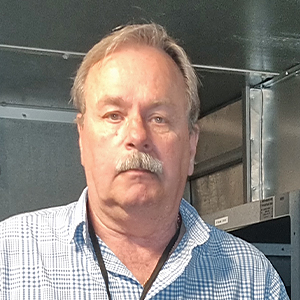Fresenius Kabi is a market leader in clinical nutrition, infusion therapy and medical technology, with around 1,100 people employed at its Swedish locations. The site in Uppsala covers almost 10,000 square meters of production and laboratory space and is home to one of the world’s most modern facilities for the production of intravenous nutrition solutions.
“A stoppage would cost hundreds of thousands of euros”
Christer Flood has worked as a facility manager at Fresenius Kabi for over 20 years. He manages projects that optimize real estate operations and production processes – including the retrofit project in Uppsala involving over 150 fans from ebm-papst. This is because the company continuously invests in new technologies to improve its climate footprint.

Besides the maintenance costs of the belt-driven fans, the main issues were efficiency and redundancy.
Christer Flood, facility manager at Fresenius Kabi
The retrofit started in 2017 with the desire to replace older belt-driven fans with a modern, energy-efficient and reliable fan solution. “There were three main reasons why we started such an extensive modernization project,” explains Christer Flood. “Besides the maintenance costs of the belt-driven fans, the main issues were efficiency and redundancy. This is because our site operates around the clock 7 days a week, and we need to be able safeguard this at all times. An unplanned stoppage costs us hundreds of thousands of euros every hour.”
More than 150 fans for 15 FanGrids
An ideal possible new solution was a FanGrid, where several fans are stacked next to and on top of each other and operated in parallel. The fan chosen by Fresenius Kabi’s installer Bravida was a RadiPac in cube design, which impressed Bravida with its compact dimensions and high level of efficiency. What’s more, the drive and control electronics were right on board, which simplified installation on site. Thanks to the MODBUS interface, Fresenius Kabi has access to the data of each individual fan in the FanGrid.
In Uppsala, 1 to 2 redundant fans were installed per FanGrid – in a total of more than 150 in 15 FanGrids. “We wanted to ensure 20 percent excess redundancy, which would allow us to flexibly ramp up the fans as needed and perform planned shutdowns without interrupting production,” explains Christer Flood.


“Despite the additional redundancy, we have achieved significant energy savings of 20-30 percent. And they could be even higher. The solution has been so successful that there has even been interest in the project at group level. After all, Fresenius has many factories around the world.”
Moving into the future with a retrofit
Christer Flood has worked closely with Johan Rodestrand, the project manager at Bravida in Linköping, since the project began in 2017. “For me, the FanGrid is the ideal solution and rightly something of a standard in the retrofit sector. The redundancy is particularly worth highlighting for projects like the one with Christer.”

For me, the FanGrid is the ideal solution and rightly something of a standard in the retrofit sector.
Johan Rodestrand, project manager at Bravida Linköping
The flexibility of the FanGrid is also particularly important: “It simply puts customers in a good position for the future because capacity can be increased or reduced as needed.” At Fresenius Kabi, Bravida has definitely built for the future. The company has already prepared for increased demand and planned additional space into the FanGrid. “This makes our work easier as it only takes a few hours to install new fans, and removal is even faster,” explains Johan Rodestrand.
He also praises Thomas Köhlmark, Technical Support Engineer at ebm-papst in Järfälla, for his support: “I like ebm-papst’s openness and curiosity when it comes to how solutions work in practice. Over the years, there are always improvements that make what is already a very good solution even better. Getting positive feedback on our suggestions from the field is valuable and very much appreciated by us as installers!”

Leave a comment